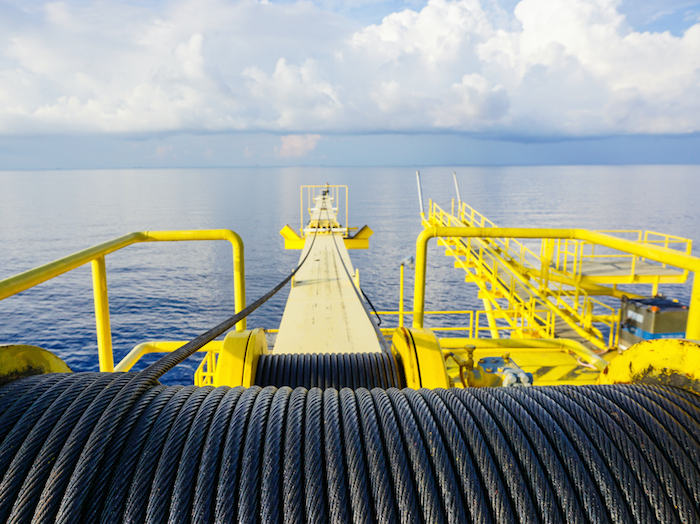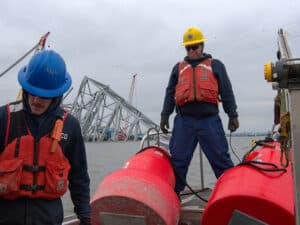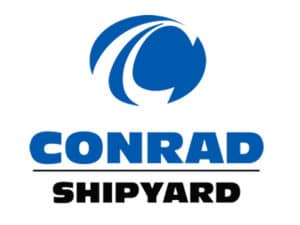
Wire rope: The importance of verifying your terminations
Written by
A steel wire rope drum on a crane offshore wellhead platform (Credit: Shutterstock/Kingtony)
By Matthew Spolarich, CDR, U.S. Coast Guard, Marine Safety Unit Houma
Wire rope and its associated cable assemblies are an essential part of the marine industry in a variety of load-handling applications. In many instances, maintenance and replacement of these cables involves multiple layers of fabrication and service providers who rely on quality management processes to ensure the correct product is supplied to the end user.
On January 4, 2021, a Fast Rescue Craft (FRC), while being manually winched to its stowed positon onboard a floating offshore installation in the Gulf of Mexico, fell approximately 135 feet into the water when its wire rope end termination failed. Luckily, the crew of the FRC had exited the craft just moments before the incident. The subject wire rope in the casualty had failed within one month of its installation.
COAST GUARD INVESTIGATES
As a result of the casualty, the Coast Guard initiated an investigation into the causal factors that contributed to the cause of the incident. While the incident is still open for investigation, the Coast Guard’s Office of Investigations and Analysis has issued two Safety Alerts related to the case (Safety Alert 04-21 and Safety Alert 08-21).
In Safety Alert 04-21, the Coast Guard requested owners, manufacturers, operators and service providers focus on verifying wire rope end terminations. As a part of the investigation, it was noted that incorrectly applied swaged fittings could have detrimental effects to the wire rope including unintentional damage to strands within the wire rope. The damage caused by the incorrectly applied fittings could lead to failure of the termination.
Since the damage to the wire rope could be within the fitting and not initially visible, the Coast Guard strongly recommended that wire rope terminations be inspected for potential abnormalities that could indicate an incorrectly applied fitting. This includes the fitting not having a uniform appearance (the fitting should be round) and the presence of ridges created when the fitting is over compressed.
A crucial part of the examination processes is comparing the fitting’s dimensions against manufacturer’s specifications and tolerances. Documentation provided as part of the cable’s fabrication should include the materials and specifications for each component of the end termination (i.e. wire rope mill cert, fitting type/model). This information can be used to compare to manufacturer tolerances for factors such as the length and diameter of the completed fitting. For the wire rope itself, factors such as construction (number of wire per strand and number of strands) and wire rope lay should be compared between the product received and specifications on the purchase order. Any examination of an end termination should also include an additional verification that the wire rope and cable materials were properly selected and match the intended components that meet the minimum safety factor for the type of service.
Different types of fittings/end terminations might decrease the Safe Working Load (SWL) of the wire rope. For example, a swaged sleeve in a turn back eye results in a 90% of better efficiency of the termination, which means that the termination has a 10% or less reduction in the overall SWL of the wire rope.
SECOND SAFETY ALERT
The second Safety Alert released as part of this investigation (Safety Alert 08-21) specifically addresses verifying the condition, manufacturing, and physical specification of wire rope that was purchased directly from Southwest Wire Rope (SWWR) or fabricated by SWWR and sold through other vendors. The Coast Guard’s investigation revealed discrepancies in SWWR’s product fabricating procedures and quality management processes.
The subject wire rope involved in the incident was found to not meet the specifications of the purchase order and receipt provided to the client by SWWR. Incorrect components were used in fabricating the end termination and the fitting was improperly applied, which resulted in unintentional damage to the wire rope that contributed in its eventual failure. The Coast Guard is currently unaware of how long this quality control measure has been an issue for the company.
As outlined in Safety Alert 04-21, the Coast Guard strongly recommends that owners, operators, manufacturers, and service providers utilizing wire rope purchased from or fabricated by SWWR do the following:
- Verify the source and manufacturer of all wire rope, and if purchases or fabricated by SWWR, carefully observe the specifications of the wire rope to ensure it matches the product that was purchased; and
- Visually examine wire rope termination for abnormalities, compare fitting dimensions, and verify the termination type does not reduce the SWL of the wire rope below the minimum safety factor for type of service.
If any abnormalities in the wire rope are detected, immediately remove the wire rope from service and make an appropriate replacement. If you are unsure whether a wire rope may be affected by these on-going concerns, please contact your nearest Coast Guard marine inspector or the Outer Continental Shelf National Center of Expertise.




